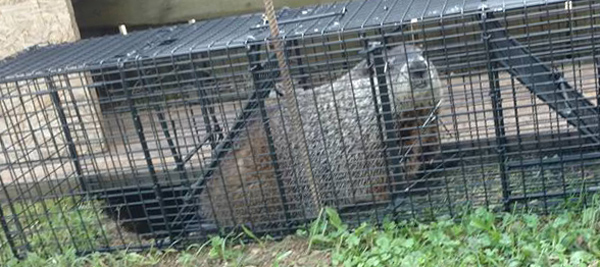- info@wildlife-removal.com
Call us for help in your town
Wildlife Removal Education
Best Ways to Get Rid of Groundhogs
Need groundhog removal in your hometown? We service over 500 USA locations! Click here to hire us in your town and check prices - updated for year 2020.
As peaceful as groundhogs seem to be, they are capable of wreaking great havoc when they gain access to your garden or decide to take up residence under your outhouse. They are particularly destructive in gardens as they consume so many vegetables and they would dig up your seeds and roots too. And when they dig and live in burrows under a house, it often results in cracks in the foundation.

Being great burrowers and good climbers too, getting rid of them could be tricky, but a good strategy would eradicate them effectively. Below are some groundhog eviction methods and you can select the one that suits you best.
Build Fences
Making fences around your garden or yard is one sure way of getting rid of groundhogs and it is best to install fences before the groundhogs enter as a preventive measure. If they are already in, you should combine fence building with trapping to eradicate them completely. For a fence to effective, it should extend below ground level by about two feet as groundhogs are good burrowers. It should also be about four feet high above ground level.
Chicken wire fencing is quite economical and is commonly used for this purpose. The wire fence should be constructed such that the base tilts out a little on the outside and its holes must not be larger than three inch squares, else the rodents will be able to squeeze through.
Exclusion
The aim of this method is to exclude groundhogs from your garden so they can only exit but not enter. Inspect your yard and block all burrows or holes made by the groundhogs, leaving only one open. Then put a one way funnel, which you can get from a local store, at the opening of the open burrow. With this, any resident groundhog can leave the burrow, but will not be able to return. Once you observe that the rodent is out, you may proceed to block the lone burrow.
Trapping
The use of live traps to catch and relocate groundhogs is popular and it is known to be very effective. You may hire or buy a live trap as they are readily available. Wash the trap to remove all human scent and thereafter, put on rubber hand gloves while handling it else the animal will perceive your scent and not go near such a trap.
Place the trap on level ground close to the mouth of an identified burrow and disguise it as much as possible with dirt, twigs, and leaves. The trap should be baited with banana, apple, or vegetables to lure the groundhog In. you may also douse your trap in some drops of ‘woodchuck lure’, this will attract the groundhog to it faster.
After the groundhog has been caught, transport the cage at least 10 miles away from your house and release the groundhog in a suitable location where it would thrive. You may also reach out to the local animal shelter for acceptable means of relocating your critter or to hand it over.
Repellents
What repellents do is to scare the groundhog away with an unpleasant taste or smell. Common repellents like mothballs, Epsom salt, ammonia, predator urine and so on have been used to evict groundhogs by many people with little success. One downside of these repellents is that you have to apply them repeatedly from time to time, as the unpleasant taste or odour usually goes away after a while or a rainfall.
Epsom salt for instance can be sprinkled on the vegetables and fruits in a garden and when the groundhog attempts to eat them, the bad taste should deter it. Likewise, the pungent smell of ammonia-soaked rags scattered around the yard should send them scurrying out. Any result obtained with repellent use is temporary at best.
Lethal Methods
Lethal trapping is not a very humane method of eliminating groundhogs as the animals may not die quickly and will suffer while at it. These traps kill by putting great pressure on the spine and internal organs of the groundhog. They should be used as a last resort only when other methods have failed.
Poisoning is another way to end it all for the pesky critter, but the danger in laying out poison is that neighbourhood pets or even children may get to the poison first. This would of course have disastrous consequences.
Shooting is also not advisable in getting rid of groundhogs. There are laws in various locations that prohibit shooting of groundhogs and other rodents and shooting can also cause disturbance to the environment. Moreover, killing a groundhog is a temporary solution as other groundhogs would soon move in to replace it if other steps are not taken to exclude them.
The best way to be rid of the wood chucks is to employ live trapping, exclusion and fencing. Or simply call in a professional!
Go back to the Groundhog Removal page.


















